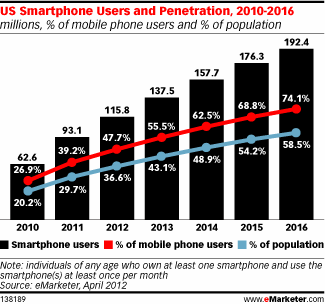Using their new and powerful mobile smartphones, an expanding class of American consumers -- 100 million strong and growing -- is helping to redefine the cultural norms in the U.S. marketplace.
According to the latest market study by eMarketer, members of the "smartphone class" stand apart from other Americans in the way they shop, communicate, consume media -- even how they use their spare time.
This class of smartphone-enabled people can be defined by their connectedness and their sense of empowerment that's attained through unfettered access to real-time online information.
"What others do with a PC, they do with their smartphones," said Catherine Boyle, eMarketer senior analyst.
Their phone is their workplace, entertainment center and their marketplace. They watch videos in coffee shops, social network at concerts, play games in waiting rooms, scan barcodes in stores and shop with their smartphone from anywhere at any time.
Moreover, their mobile online behaviors are rerouting the traditional path to purchase and they are proving to the rest of America that spare moments can be productive ones, too.
eMarketer estimates nearly 116 million Americans will use a smartphone at least monthly by the end of 2012, up from 93.1 million in 2011. By 2013, they will represent over half of all mobile phone users, and by 2016, nearly three in five consumers will have a smartphone.
The U.S. smartphone class is not defined by age, gender, income or race. Instead, it's defined by shared behaviors. Understanding the common behavioral traits that unite the class makes members easy to recognize and underscores the influence this class of consumers is having on how Americans communicate, consume media and shop.
One of those behaviors is to always be snacking content. The smartphone class doesn’t tolerate dull moments; members turn to their phones for instant gratification. Depending on their mood in the moment, gratification might mean completing a quick task or finding a fun distraction.
For marketers, this rising content consumption means an increasing number of touch-points where they can reach consumers. eMarketer forecasts double-digit growth in mobile gaming as well as music and video consumption among the smartphone class through 2015.
"Snacking on mobile in small amounts throughout the day can be as lucrative to brands as it is gratifying to members of the smartphone class," said Boyle. "The five minutes grazing on news in the morning, the 15 minutes playing a game at lunch and the two minutes watching a video at the grocery store are all opportunities for marketers to get a message across or close a sale."
